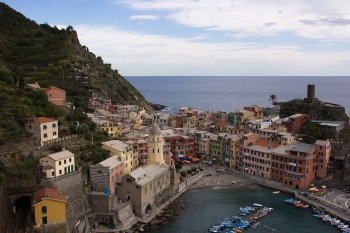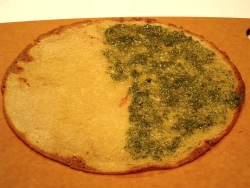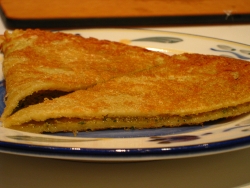Last fall we vacationed in northern Italy. It was the first time I had been to Europe, and it was really an incredible experience. Of course, part of my interest in vacationing is sampling the local foods in as much variety as possible, and one of my favorite areas for eating during our trip was along the Ligurian coast. Naturally the seafood dishes were incredible, but one seemingly unassuming dish really stole my heart – Farinata.
Farinata is a sort of pancake or crepe made primarily from chickpea or garbanzo flour (farina di ceci). The day we tried it out, we were touring through the Cinque Terre, an area of the Ligurian coast comprised of five villages with footpaths and railways connecting them. It was one of the most gorgeous places we visited (on a trip filled with gorgeous destinations). The farinata was served warm with pesto (which is also said to have originated in Liguria) – and wow was it ever tasty. It didn’t look like much. I told Sean he should really try it out, and he gave me that half-hearted, clearly-humoring-me nod of ascent and took a bite. He too was in heaven, and we split the rest of the farinata between us. It was incredibly filling too – we were both quite full after sharing a single order.

I had picked up several cookbooks in Italy. In an effort to avoid the heavily photographed, clearly-meant-as-souvenirs cookbooks, I purchased only books written in Italian with a definite leaning toward those with unassuming covers. It’s not the most scientific approach, I realize, but the one I took nonetheless. This means that anytime I want to cook something from one of the books, I go through a sometimes arduous translation process, that’s often filled with guesswork. The farinata was the first recipe I translated (and then heavily adapted).
Almost immediately upon returning from Italy and translating the recipe, I purchased the garbanzo flour, however, it has done nothing but take up space in my pantry since then. In cleaning out my cabinets last week, I re-discovered the flour and decided to give my translated recipe a go. Also, since I love pesto and it worked so well with the farinata before, I decided to make some of that as well. However, because I didn’t plant any sweet basil this year, and my sage plant has gone absolutely berzerker, I figured we’d try out some sage pesto instead. The sage pesto turned out nicely – it was still every bit as aromatic, and its flavor was rich and earthy. It went really well with the farinata.
FARINATA
Mix together the chickpea flour, the water, and the salt in a medium-sized bowl till all the lumps are removed. Allow this to sit for at least an hour, preferably overnight. Just before using the batter, stir in the olive oil.
Heat a well-seasoned 12-inch cast iron skillet in a 450-degree (F) oven. Once it’s preheated, remove the pan from the oven, and pour in about ½ T of olive oil and carefully swirl to coat, tilting the pan a bit to allow it a bit up onto the lower third of the sides as well.
Pour in about 1 cup of the batter, evenly covering the bottom of the pan. It should sizzle as the batter hits the hot oil. Place the pan back in the oven and cook for roughly 12-15 minutes. You’re watching to see the edges turn brown and the top begin to color a bit. When poked with a fork, the batter should be set and a bit crispy on the top.
When the farinata is sufficiently cooked, remove the pan from the oven and gently work your way around and under the farinata with a plastic or wooden spatula. Carefully move it to a cutting board, and sprinkle with the black pepper.
Serve plain, or with a sprinkling of your favorite hard Italian cheese (Pecorino Romano, Parmigiano-Reggiano, Stravecchio, etc.), or go full-on Ligurian and spread it with some pesto. Fold in half and cut into wedges.

